PROFESSIONAL INVITATIONAL EXHIBIT AT MID-ATLANTIC SPRING FESTIVAL
+6
Ed Trout
Mark
jgeanangel
Todd Ellis
Russell Coker
William N. Valavanis
10 posters
Page 1 of 1
 PROFESSIONAL INVITATIONAL EXHIBIT AT MID-ATLANTIC SPRING FESTIVAL
PROFESSIONAL INVITATIONAL EXHIBIT AT MID-ATLANTIC SPRING FESTIVAL
The 2011 Mid-Atlantic Bonsai Society Spring Festival opened yesterday in Harrisburg, PA. Jim Gillespie has been trying to organize a professional invitational exhibit for years and finally got the approval to organize the display at this year's event.
The special exhibit committee was composed of Rhoda Kleinman, Irving Kleinman, Pauline Muth, Mark Schmuck, Dave Tettemer and Lucille Miller. Jim Gillespie carefully selected 16 professionals to display their bonsai. I was honored to be asked to share my bonsai with the attendees. This is the same room where the International Stone Appreciation Symposium has had their "speaker's Display" in the past so it was excellent for such a display.
Enjoy the bonsai!
Bill

Entrance view

Sectional view
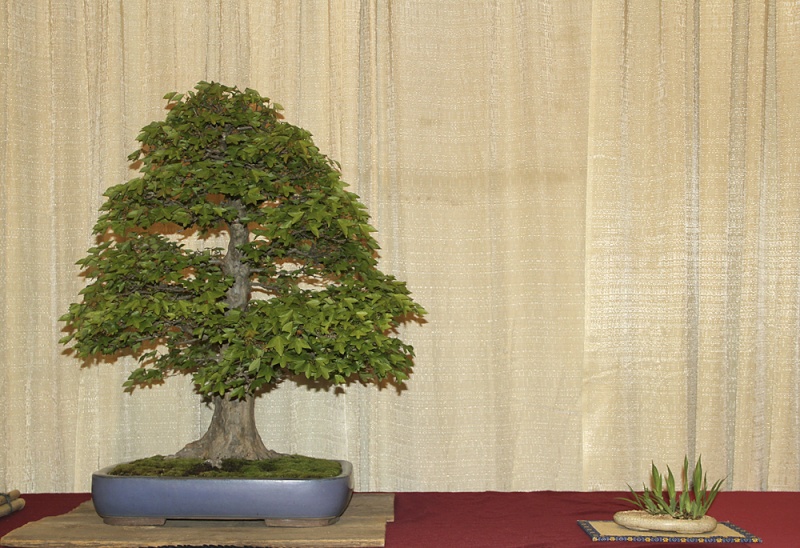
Trident maple by Julian Adams

Japanese maple by Jim Doyle

Ginkgo by Jim Gillespie

Korean hornbeam by Todd Hansen
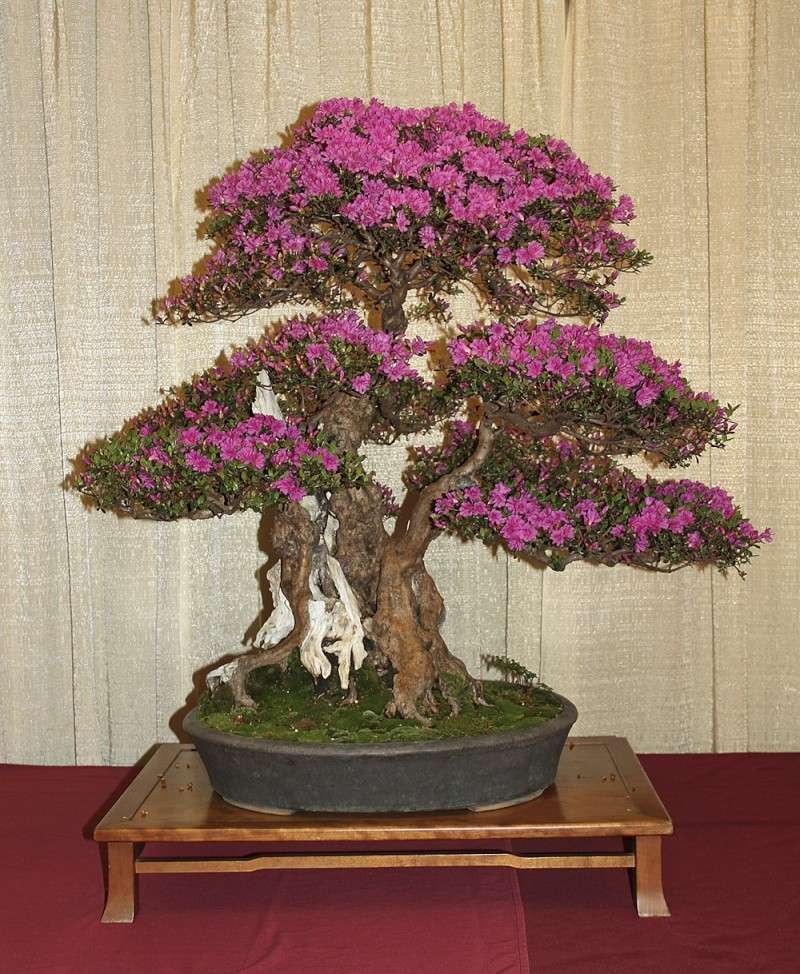
Kurume Azalea by The Kennett Collection

Robusta Green juniper by Ron Lange

Japanese five-needle pine by Howard McNeal

Cork-bark Chinese elm by Frank Mihalic

Satsuki azalea by Pauline Muth

Dwarf hinoki cypress by F. Chase Rosade

Jaboticaba by Solita Rosade

Field juniper by Martin Schmalenberg

Sargents juniper by Sean Smith

Sargents juniper by Ron Lehman
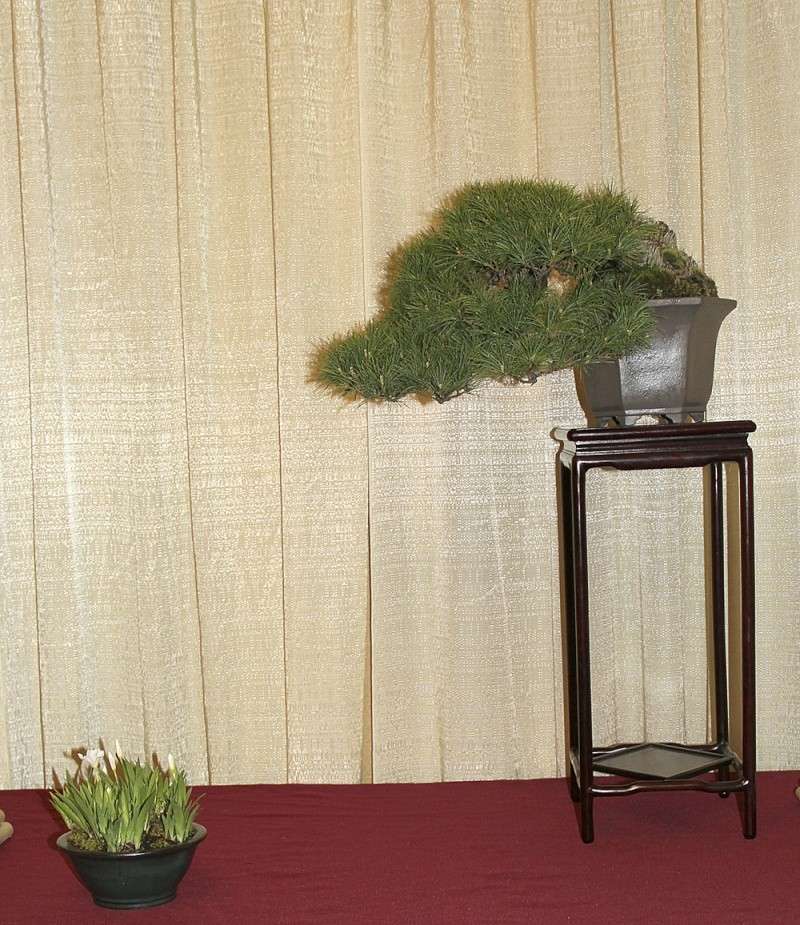
Japanese five-needle pine by Robert Mahler

Deshojo Japanese maple by William N. Valavanis
The special exhibit committee was composed of Rhoda Kleinman, Irving Kleinman, Pauline Muth, Mark Schmuck, Dave Tettemer and Lucille Miller. Jim Gillespie carefully selected 16 professionals to display their bonsai. I was honored to be asked to share my bonsai with the attendees. This is the same room where the International Stone Appreciation Symposium has had their "speaker's Display" in the past so it was excellent for such a display.
Enjoy the bonsai!
Bill

Entrance view

Sectional view

Trident maple by Julian Adams

Japanese maple by Jim Doyle

Ginkgo by Jim Gillespie

Korean hornbeam by Todd Hansen

Kurume Azalea by The Kennett Collection

Robusta Green juniper by Ron Lange

Japanese five-needle pine by Howard McNeal

Cork-bark Chinese elm by Frank Mihalic

Satsuki azalea by Pauline Muth

Dwarf hinoki cypress by F. Chase Rosade

Jaboticaba by Solita Rosade

Field juniper by Martin Schmalenberg

Sargents juniper by Sean Smith

Sargents juniper by Ron Lehman

Japanese five-needle pine by Robert Mahler

Deshojo Japanese maple by William N. Valavanis
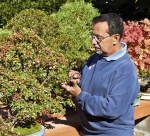
William N. Valavanis- Member
 Re: PROFESSIONAL INVITATIONAL EXHIBIT AT MID-ATLANTIC SPRING FESTIVAL
Re: PROFESSIONAL INVITATIONAL EXHIBIT AT MID-ATLANTIC SPRING FESTIVAL
Great Collection thanks for taking the time to Post here Bill... 
Guest- Guest
 Re: PROFESSIONAL INVITATIONAL EXHIBIT AT MID-ATLANTIC SPRING FESTIVAL
Re: PROFESSIONAL INVITATIONAL EXHIBIT AT MID-ATLANTIC SPRING FESTIVAL
Very nice, hope you have more pictures to share. How does this committee define "professional"? Just curious.

Russell Coker- Member
 Re: PROFESSIONAL INVITATIONAL EXHIBIT AT MID-ATLANTIC SPRING FESTIVAL
Re: PROFESSIONAL INVITATIONAL EXHIBIT AT MID-ATLANTIC SPRING FESTIVAL
Bill, thanks for posting these trees. They are lovely. One day I will get to that show! I am intrigued by Ron Lang's tree and container; very artistic and modern. I liked the variety of scrolls as well. My favorite accent is Chase's. Julian's Trident looks very nice!
Best,
Todd
Best,
Todd
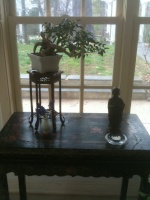
Todd Ellis- Member
 PROFESSIONAL INVITATIONAL EXHIBIT AT MID-ATLANTIC SPRING FESTIVAL
PROFESSIONAL INVITATIONAL EXHIBIT AT MID-ATLANTIC SPRING FESTIVAL
Some great compositions here but I'm surprised to see a lack of natives amongst the displays. Are the professionals all importers too?
Guest- Guest
 Re: PROFESSIONAL INVITATIONAL EXHIBIT AT MID-ATLANTIC SPRING FESTIVAL
Re: PROFESSIONAL INVITATIONAL EXHIBIT AT MID-ATLANTIC SPRING FESTIVAL
Thanks for sharing Bill!! Was there any judging?
Several of the displays were very NICE but to my eye, none topped your maple. Every detail is perfect!
John
Several of the displays were very NICE but to my eye, none topped your maple. Every detail is perfect!
John
jgeanangel- Member
 Re: PROFESSIONAL INVITATIONAL EXHIBIT AT MID-ATLANTIC SPRING FESTIVAL
Re: PROFESSIONAL INVITATIONAL EXHIBIT AT MID-ATLANTIC SPRING FESTIVAL
Will,
There is one, Marty Schmalenberg's Common Juniper is a great Native Bonsai. The tree is on the cover of
International BONSAI magazine 2011 no.#1 and an excellent article on its development also included.
A note of interest, Bill Valavanis's amazing Deshojo was trained by Bill from a rooted cutting for over 20 years.
Mark
There is one, Marty Schmalenberg's Common Juniper is a great Native Bonsai. The tree is on the cover of
International BONSAI magazine 2011 no.#1 and an excellent article on its development also included.
A note of interest, Bill Valavanis's amazing Deshojo was trained by Bill from a rooted cutting for over 20 years.
Mark
Mark- Member
 Re: PROFESSIONAL INVITATIONAL EXHIBIT AT MID-ATLANTIC SPRING FESTIVAL
Re: PROFESSIONAL INVITATIONAL EXHIBIT AT MID-ATLANTIC SPRING FESTIVAL
Will,
There was only one "Native North American species" bonsai displayed in this exhibit. Of the 16 bonsai here only 5 were imported. The other 11 bonsai were trained from overgrown landscape plants, nursery stock, seedlings and cuttings. Most of the exhibitors are not importers. We don't need to import fine quality bonsai here because we have a long history of people training bonsai and also the most popular species used for bonsai are commonly available in the landscape or at nurseries.
There was no judging of this special exhibition.
I do not know how the committee determined who is a professional. All I know is that I was honored to display and put quite a bit of effort into my personal display. Over one month of moving my Deshojo Japanese maple inside at night, outside in the bright sun during the day (not too many in cloudy Rochester, NY) to intensify the bright red leaves at their "Peak" of beauty was necessary.
This was the first time I displayed this particular antique (280-300 years old) scroll. A special occasion was necessary for it's debut in America and this was perfect timing. Although the cloudy moon can be clearly seen by most of the public, upon close examination one can see small white objects falling. They are falling cherry blossoms which naturally drop in late spring. Timing and seasonality are very important for a fine bonsai display. Often a two week period theme ahead of the actual exhibit is used. Since the cherries are blossoming outside now (in Pennsylvania at least), the blossom petals will begin dropping in a couple of weeks.
My accessory planting took time too. Several weeks ago I went to a garden center and spent over $80 on many perennials to be used. They were all carefully potted in appropriate containers and watched to see how they grew, and flowered too. Five different accessories were finally selected for this display.
For over a week I would ask my students and learned friends which was most appropriate for this display, then the flat stand for it. There was a round black disc and two Chinese quince burrals (one roundish and the other long and irregular) to select from. That took some time too.
Generally, when I display a bonsai the first thing I do is to select the bonsai. Then the display table for it. Once that is determined the accessory must be chosen. For MY taste if the main bonsai is in a glazed container the accessory must be in an unglazed container. If the bonsai is in a symmetrical container (round, square or equal sided, 6 or the accessory must be in an asymmetrical container (oval, rectangular or stone). If the bonsai is in an asymmetrical container (oval, rectangular or stone) the accessory must be in a symmetrical container (round, square or equal sided). Since the Deshojo Japanese maple was in an old oval container (Tokoname ware from the Koyo Kiln), which was blue/green glazed I selected many round containers of the appropriate size. Then after they were selected the perennials were planted and I waited to see how they grew and which looked the best.
the accessory must be in an asymmetrical container (oval, rectangular or stone). If the bonsai is in an asymmetrical container (oval, rectangular or stone) the accessory must be in a symmetrical container (round, square or equal sided). Since the Deshojo Japanese maple was in an old oval container (Tokoname ware from the Koyo Kiln), which was blue/green glazed I selected many round containers of the appropriate size. Then after they were selected the perennials were planted and I waited to see how they grew and which looked the best.
Finally, the scroll was selected for this display. Many people did not notice the falling cherry blossoms at the exhibition. In fact my wife, Diane, told me NOT to bring the scroll as many public would think the white spots were holes or that the scroll was damaged. Of course, I did not listen to my wife and took the scroll. I told her that this exhibit was not for the general public and that I was trying to "raise the bar" and improve the quality of bonsai display. Not too many people noticed the falling cherry blossoms (Yasuo Mitsuya, Hideko Metaxas and Kathy Shaner for example), but once I explained the theme of the scroll they all enjoyed and understood my display.
Anyways, I enjoyed presenting and sharing the beauty of my Deshojo Japanese maple with the attendees of the Mid-Atlantic Bonsai Festival and also here with readers of the IBC.
Bill
There was only one "Native North American species" bonsai displayed in this exhibit. Of the 16 bonsai here only 5 were imported. The other 11 bonsai were trained from overgrown landscape plants, nursery stock, seedlings and cuttings. Most of the exhibitors are not importers. We don't need to import fine quality bonsai here because we have a long history of people training bonsai and also the most popular species used for bonsai are commonly available in the landscape or at nurseries.
There was no judging of this special exhibition.
I do not know how the committee determined who is a professional. All I know is that I was honored to display and put quite a bit of effort into my personal display. Over one month of moving my Deshojo Japanese maple inside at night, outside in the bright sun during the day (not too many in cloudy Rochester, NY) to intensify the bright red leaves at their "Peak" of beauty was necessary.
This was the first time I displayed this particular antique (280-300 years old) scroll. A special occasion was necessary for it's debut in America and this was perfect timing. Although the cloudy moon can be clearly seen by most of the public, upon close examination one can see small white objects falling. They are falling cherry blossoms which naturally drop in late spring. Timing and seasonality are very important for a fine bonsai display. Often a two week period theme ahead of the actual exhibit is used. Since the cherries are blossoming outside now (in Pennsylvania at least), the blossom petals will begin dropping in a couple of weeks.
My accessory planting took time too. Several weeks ago I went to a garden center and spent over $80 on many perennials to be used. They were all carefully potted in appropriate containers and watched to see how they grew, and flowered too. Five different accessories were finally selected for this display.
For over a week I would ask my students and learned friends which was most appropriate for this display, then the flat stand for it. There was a round black disc and two Chinese quince burrals (one roundish and the other long and irregular) to select from. That took some time too.
Generally, when I display a bonsai the first thing I do is to select the bonsai. Then the display table for it. Once that is determined the accessory must be chosen. For MY taste if the main bonsai is in a glazed container the accessory must be in an unglazed container. If the bonsai is in a symmetrical container (round, square or equal sided, 6 or
Finally, the scroll was selected for this display. Many people did not notice the falling cherry blossoms at the exhibition. In fact my wife, Diane, told me NOT to bring the scroll as many public would think the white spots were holes or that the scroll was damaged. Of course, I did not listen to my wife and took the scroll. I told her that this exhibit was not for the general public and that I was trying to "raise the bar" and improve the quality of bonsai display. Not too many people noticed the falling cherry blossoms (Yasuo Mitsuya, Hideko Metaxas and Kathy Shaner for example), but once I explained the theme of the scroll they all enjoyed and understood my display.
Anyways, I enjoyed presenting and sharing the beauty of my Deshojo Japanese maple with the attendees of the Mid-Atlantic Bonsai Festival and also here with readers of the IBC.
Bill

William N. Valavanis- Member
 Re: PROFESSIONAL INVITATIONAL EXHIBIT AT MID-ATLANTIC SPRING FESTIVAL
Re: PROFESSIONAL INVITATIONAL EXHIBIT AT MID-ATLANTIC SPRING FESTIVAL
Wonderful display Bill. Thank you for posting.
Ed
Ed Trout- Member
 Re: PROFESSIONAL INVITATIONAL EXHIBIT AT MID-ATLANTIC SPRING FESTIVAL
Re: PROFESSIONAL INVITATIONAL EXHIBIT AT MID-ATLANTIC SPRING FESTIVAL
Talking of Cherries.... the cherry was the detailing of the perspective on cake of Great Bonsai...
Ravi
Ravi

Ravi Kiran- Member
 Re: PROFESSIONAL INVITATIONAL EXHIBIT AT MID-ATLANTIC SPRING FESTIVAL
Re: PROFESSIONAL INVITATIONAL EXHIBIT AT MID-ATLANTIC SPRING FESTIVAL
As always very knoweledgable tales of the show and, a very classy display. All the other trees are great as well. Glad everything went well.
Neil
Neil

Neil Jaeger- Member
 Re: PROFESSIONAL INVITATIONAL EXHIBIT AT MID-ATLANTIC SPRING FESTIVAL
Re: PROFESSIONAL INVITATIONAL EXHIBIT AT MID-ATLANTIC SPRING FESTIVAL
Thanks to Bill for posting some wonderful pictures of this exhibit. Jim Gillespie did yeomans work in getting all the trees assembled for this show. Colin Lewis suggested in 2004 that MidAtlantic do something like this display to "raise the bar" so to speak and to encourage the member clubs to raise the level of their displays as well. The member exhibits were excellent this year and I hope the Professional exhibit will have the desired effect. We shall see next year!! I attended a critique of the members exhibit with Steve Tolley and he said he was impressed with the potential of many of the trees and said several were potential future masterpieces. Jim and I spent a good amount of time setting up the exhibit and it came out much better than we had hoped!! We were still aiming the lights at midnight on friday!! Again thanks to Bill for posting these pix and we hope the PIE(Professional Invitational Exhibit) Exhibit will become a new tradition at the MidAtlantic Festival.
I would like to thank Bill as well for his knowledge and inspiration when it comes to display. I appreciate the chance to help setup displays and discuss them with people like Bill , Sean Smith, Jim Gillespie and Chase Rosade. I consider display to be an essential part of the bonsai experience and I have been lucky to have some great practitioners of the art allow me to learn from them.
I would like to thank Bill as well for his knowledge and inspiration when it comes to display. I appreciate the chance to help setup displays and discuss them with people like Bill , Sean Smith, Jim Gillespie and Chase Rosade. I consider display to be an essential part of the bonsai experience and I have been lucky to have some great practitioners of the art allow me to learn from them.

Paul Landis- Member
 Similar topics
Similar topics» 2013 MID ATLANTIC SPRING FESTIVAL EXHIBIT
» MID-ATLANTIC BONSAI SPRING FESTIVAL 2012
» Bonsai Exhibit @ Epcot's Flower & garden Festival 2009
» Bonsai exhibition at Spring Flower Festival (viet Nam)
» Bonsai anh Lansdcaping in Viet Nam Spring Flower Festival Show
» MID-ATLANTIC BONSAI SPRING FESTIVAL 2012
» Bonsai Exhibit @ Epcot's Flower & garden Festival 2009
» Bonsai exhibition at Spring Flower Festival (viet Nam)
» Bonsai anh Lansdcaping in Viet Nam Spring Flower Festival Show
Page 1 of 1
Permissions in this forum:
You cannot reply to topics in this forum






